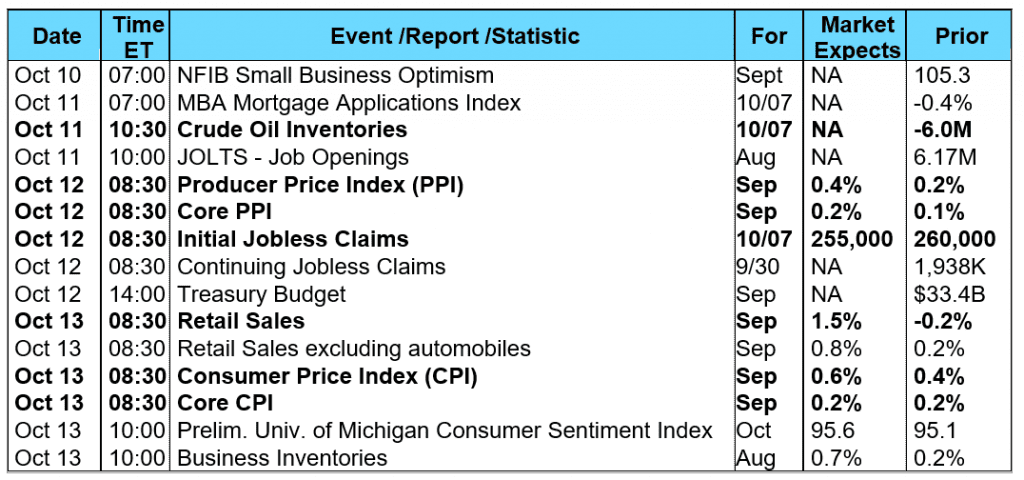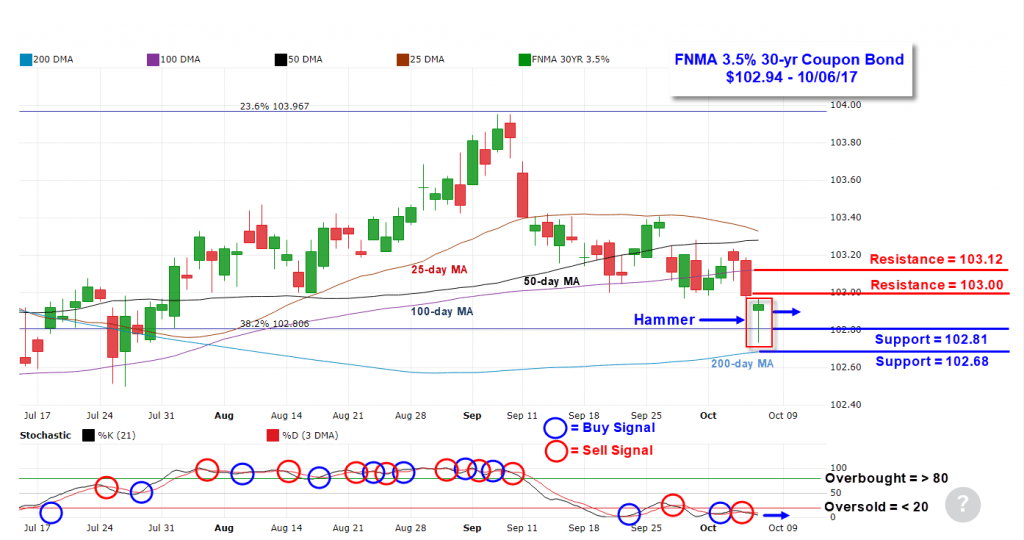The stock market posted another good week of gains resulting in the major indexes reaching a new series of record highs. Meanwhile, bond yields moved a little higher following better than expected economic data earlier in the week and after Friday’s release of the September jobs report showing strong gains in wage growth with an increase of 0.5% in average hourly earnings. Investors showed more concern over possible wage-based inflation than a -33,000 decline in Nonfarm Payrolls for September that was negatively impacted by the effects of hurricanes Harvey and Irma. Most of the jobs lost were among restaurant and bar workers and many of these will return in future months. Economists had expected new job growth of 75,000 rather than a loss, but many economists are expecting a rebound in the October payrolls number. Comments made by Philadelphia Federal Reserve President Patrick Harker also played a role in the rise in bond yields after he stated he had “penciled in” a December rate hike even though inflation readings remain low. The fed funds futures market is now showing the implied probability of a rate hike occurring in December has increased to 90.6%. In housing, mortgage application volume fell during the week ending September 29. The Mortgage Bankers Association (MBA) reported their overall seasonally adjusted Market Composite Index (application volume) declined by 0.4%. The seasonally adjusted Purchase Index increased 1.0% from the prior week while the Refinance Index fell 2.0%. Overall, the refinance portion of mortgage activity decreased to 50.1% of total applications from 50.8% in the prior week. The adjustable-rate mortgage share of activity decreased to 6.0% of total applications from 6.5%. According to the MBA, the average contract interest rate for 30-year fixed-rate mortgages with a conforming loan balance increased to 4.12% from 4.11% with points increasing to 0.45 from 0.40. For the week, the FNMA 3.5% coupon bond lost 7.80 basis points to close at $102.938. The 10-year Treasury yield increased 2.17 basis points to end at 2.3607%. The major stock indexes ended the week higher. The Dow Jones Industrial Average gained 368.58 points to close at 22,773.67. The NASDAQ Composite Index increased 94.22 points to close at 6,590.18 and the S&P 500 Index advanced 29.97 points to close at 2,549.33. Year to date on a total return basis, the Dow Jones Industrial Average has gained 15.24%, the NASDAQ Composite Index has advanced 22.42%, and the S&P 500 Index has added 13.87%. This past week, the national average 30-year mortgage rate edged higher to 3.99% from 3.97%; the 15-year mortgage rate increased to 3.27% from 3.24%; the 5/1 ARM mortgage rate rose to 3.22% from 3.21% and the FHA 30-year rate was unchanged at 3.60%. Jumbo 30-year rates increased to 4.19% from 4.17%. Economic Calendar - for the Week of October 9, 2017 Economic reports having the greatest potential impact on the financial markets are highlighted in bold  Mortgage Rate Forecast with Chart - FNMA 30-Year 3.5% Coupon Bond The FNMA 30-year 3.5% coupon bond ($102.94, -7.80 bp) traded within a 50.0 basis point range between a weekly intraday low of $102.734 on Friday and a weekly intraday high of $103.234 on Wednesday before closing the week at $102.938 on Friday. Mortgage bond prices fell below the $103 support level on Thursday and subsequently tested the next lower support level of $102.68 on Friday before improving from the intraday low $102.73. The bond is now significantly “oversold” and poised for a rebound higher to test the nearest resistance level at $103. Friday’s candlestick is known as a “Hammer.” The Hammer is a potential bullish reversal pattern that forms after a decline. Additionally, hammers can mark market bottoms or support levels. The low of the long lower shadow suggests sellers drove prices lower during the session, but the strong finish indicates buyers regained control to end the session on a strong note. While this may seem enough to act on, hammers require further bullish confirmation. A positive close on Monday could provide the bullish confirmation leading to a move higher to test overhead resistance. A break above resistance levels would lead to a slight improvement in mortgage rates, but a sideways move between support and resistance should result in rates remaining relatively stable.
Mortgage Rate Forecast with Chart - FNMA 30-Year 3.5% Coupon Bond The FNMA 30-year 3.5% coupon bond ($102.94, -7.80 bp) traded within a 50.0 basis point range between a weekly intraday low of $102.734 on Friday and a weekly intraday high of $103.234 on Wednesday before closing the week at $102.938 on Friday. Mortgage bond prices fell below the $103 support level on Thursday and subsequently tested the next lower support level of $102.68 on Friday before improving from the intraday low $102.73. The bond is now significantly “oversold” and poised for a rebound higher to test the nearest resistance level at $103. Friday’s candlestick is known as a “Hammer.” The Hammer is a potential bullish reversal pattern that forms after a decline. Additionally, hammers can mark market bottoms or support levels. The low of the long lower shadow suggests sellers drove prices lower during the session, but the strong finish indicates buyers regained control to end the session on a strong note. While this may seem enough to act on, hammers require further bullish confirmation. A positive close on Monday could provide the bullish confirmation leading to a move higher to test overhead resistance. A break above resistance levels would lead to a slight improvement in mortgage rates, but a sideways move between support and resistance should result in rates remaining relatively stable. 
 Mortgage Rate Forecast with Chart - FNMA 30-Year 3.5% Coupon Bond The FNMA 30-year 3.5% coupon bond ($102.94, -7.80 bp) traded within a 50.0 basis point range between a weekly intraday low of $102.734 on Friday and a weekly intraday high of $103.234 on Wednesday before closing the week at $102.938 on Friday. Mortgage bond prices fell below the $103 support level on Thursday and subsequently tested the next lower support level of $102.68 on Friday before improving from the intraday low $102.73. The bond is now significantly “oversold” and poised for a rebound higher to test the nearest resistance level at $103. Friday’s candlestick is known as a “Hammer.” The Hammer is a potential bullish reversal pattern that forms after a decline. Additionally, hammers can mark market bottoms or support levels. The low of the long lower shadow suggests sellers drove prices lower during the session, but the strong finish indicates buyers regained control to end the session on a strong note. While this may seem enough to act on, hammers require further bullish confirmation. A positive close on Monday could provide the bullish confirmation leading to a move higher to test overhead resistance. A break above resistance levels would lead to a slight improvement in mortgage rates, but a sideways move between support and resistance should result in rates remaining relatively stable.
Mortgage Rate Forecast with Chart - FNMA 30-Year 3.5% Coupon Bond The FNMA 30-year 3.5% coupon bond ($102.94, -7.80 bp) traded within a 50.0 basis point range between a weekly intraday low of $102.734 on Friday and a weekly intraday high of $103.234 on Wednesday before closing the week at $102.938 on Friday. Mortgage bond prices fell below the $103 support level on Thursday and subsequently tested the next lower support level of $102.68 on Friday before improving from the intraday low $102.73. The bond is now significantly “oversold” and poised for a rebound higher to test the nearest resistance level at $103. Friday’s candlestick is known as a “Hammer.” The Hammer is a potential bullish reversal pattern that forms after a decline. Additionally, hammers can mark market bottoms or support levels. The low of the long lower shadow suggests sellers drove prices lower during the session, but the strong finish indicates buyers regained control to end the session on a strong note. While this may seem enough to act on, hammers require further bullish confirmation. A positive close on Monday could provide the bullish confirmation leading to a move higher to test overhead resistance. A break above resistance levels would lead to a slight improvement in mortgage rates, but a sideways move between support and resistance should result in rates remaining relatively stable. 
